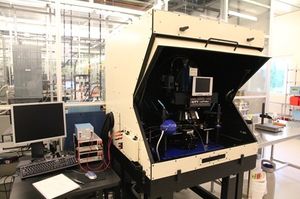IR Thermal Microscope (QFI)
| ||||||||||||||||||||||||||||||
About
- The InfraScope "HotSpot" software is a fault isolation tool for semiconductor failure analysis. The InfraScope detects thermal infrared photons emitted from hot areas on semiconductor circuits. Such hot spot sites often mark the location of a process fault or damaged location of a circuit, such as a short circuit.
- The "Emmi" software detects photons emitted from electron-hole recombination sites on semiconductor circuits. Such recombination sites often mark the location of a process fault or damaged location of a circuit. The NIR cameral operates at 400nm - 1,000nm wavelength.
- The "Thermal Map" software allows the user to perform temperature mapping of materials and devices. The user easily determines the exact temperature at any point by color or by simply positioning the mouse arrow over the desired point and reading the desired temperature. This technique saves literally hundreds of hours over non-infrared techniques and it doesn't damage or affect the part in any way.
Capabilities
- 6 inch heated chuck, default temp = 40°C
- Micrometer probes
- Dark box
- Two Keithley DC power supplies (SMU's). 0-200VDC & 0-1000VDC.
- Users may bring their own power supplies as needed for their specific devices and material testing.
- The tool has better than 2.7µm resolution.
- Cameras & Microscope objectives:
- Visible: 1x Macro
- Visible + Near Infrared: 2.5x, 5x, 20x, 50x
- Mid-IR: 2x, 5x, 15x
- The MWIR camera (LN2 cooled InSb) nominally operates at 1um - 5um wavelength with filtering nominally from 2-4µm, although intentional light emission beyond the filtered range is commonly observed.
- Users working on Mid-Infrared photonics can use this to take microscope observations of sub-threshold MIR optical emission. Do not shine high power laser emission towards the camera!
Manuals & Software
- QFI Infrascope User Manual
- Offline analysis software is available for the ThermalMap and HotSpot tools. Email Mike Barreraz for access.
- Python scripts to analyze thermal map data are also available, here: Utilities > Python Scripts
